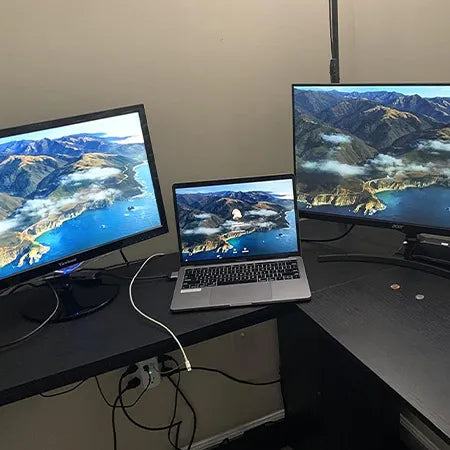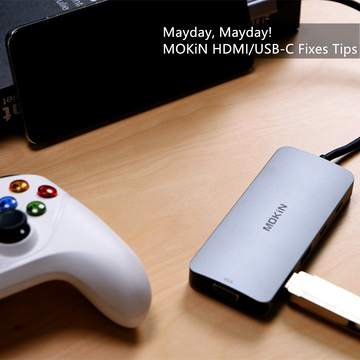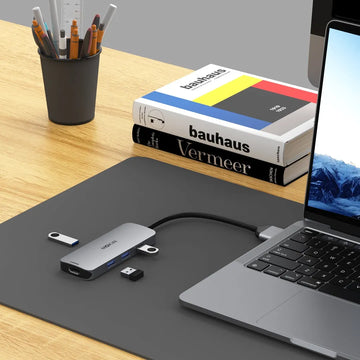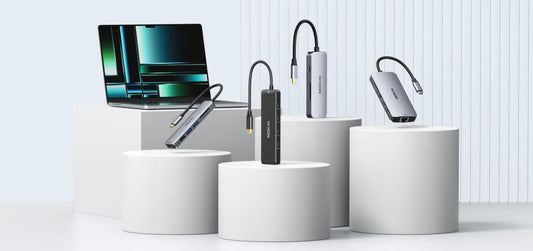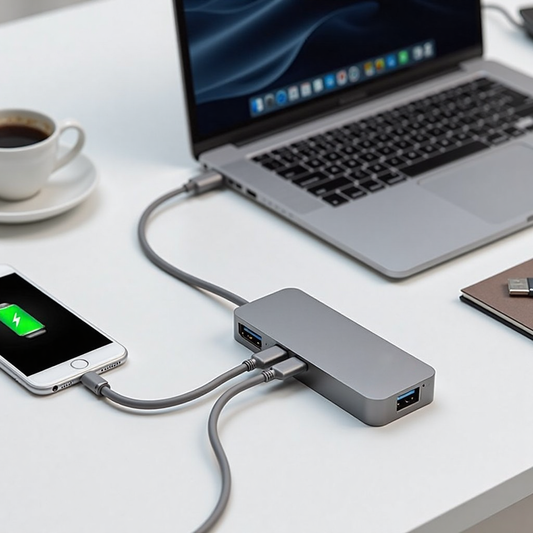6 Solutions for DisplayPort to HDMI Connection
Contents
Introduction:
1.1 DisplayPort & HDMI
DisplayPort and HDMI are popular ports for connecting kinds of devices. They can replace DVI and VGA.
Instead of requiring multiple remotes and additional cables, ARC allows you to simplify your home theater setup. This protocol offers two-way communication between devices over a single HDMI connection.
Most TVs have HDMI ports. Most desktop computers support HDMI.
For TV sets and A/V receivers, connecting Gaming Consoles to the HDMI of PlayStation 4 is optimal. Many laptops also have HDMI outputs.
Four HDMI cable types are different.
HDMI supports video resolutions of 720p.
Standard HDMI cables with Ethernet have the same bandwidth as standard HDMI cables and support 100Mbps Ethernet.
High-speed HDMI cables support 1080p or higher resolutions and 3D video with more bandwidth.
High-speed HDMI cables with Ethernet have the same features as high-speed cables. It additionally supports 100Mbps Ethernet support.
You might find the following types of HDMI ports on various displays.
HDMI 1.4 supports high video resolutions of up to 4K. And it is with a bandwidth of 10.2Gbps.
HDMI 2.0 supports resolutions up to 4K at 60 Hz. Other versions have HDR capabilities and have a bandwidth of 18Gbps.
DisplayPort can deliver digital content at higher resolutions. And it has bit depths, with the the highest refresh rates available from a single A/V connector.
DisplayPort Certified products with Multi-Stream Transport allow for multiple screens. Several screens are from a single DisplayPort source. MST uses a DP converter or daisy-chaining monitors with that capability.
The DP connector itself is typically for PC gaming screens. DP ports are less common on TVs. They are often on larger gaming screens, which provide audio and high-definition content protection.
DisplayPort has lots of benefits over VGA and DVI. The DisplayPort interface is suitable for PC and home entertainment devices and is cheaper to manufacture.
Understanding the Technical Differences
|
Resolution/Refresh Rate |
Multi Displays |
Audio Transmission |
Compatibility |
Cable |
|
|
HDMI |
HDMI2.1 8K@120Hz |
Not support MST
It can achieve MST through a DisplayPort to HDMI adapter. |
ARC |
Nearly Universal for home audio/video device
|
pin Cable
No Physical Latch
|
|
DP |
DisplayPort 2.0 8K@240Hz |
Supports daisy-chaining
It allows you to connect multiple displays to a single DisplayPort.
|
Multi-Channel Audio Transmission |
Especially for computers
|
pin Cable
With a Physical Latch
Supports Long-distance Connectivity |
Conclusion
DisplayPort and HDMI perform similarly, but they have their features.
HDMI is compatible with more devices, while DisplayPort is typically for computers. DisplayPort is a great option for connecting your computer to the additional monitor. So, those applications have better resolutions and refresh rates.
HDMI can work with many daily electronics, such as TVs and home theater systems. Selecting the optimal one for your device to get the best audio and video transmission.
The MacBook HDMI adapter can only support a single video stream and audio stream. So, it is only compatible with one monitor at a time. They have an Audio Return Channel. The function sends audio from your TV to the AV receiver.
Sometimes, PC users may need help with mismatched ports on their laptops. An adapter can connect a DisplayPort to HDMI. The display port to HDMI adapter is ideal for those who manage to make an efficient workstation.
The DisplayPort to HDMI active adapter can seamlessly transfer information across the differing connectors. However, the cable only supports a resolution of 1080p and not 4K. Transitioning video and audio from one standard to another might affect the display result on the screen.
HDMI to DP ports are usually active.
Converting signals from HDMI to Display ports usually requires active adapters. In other words, these adapters require an external power source to work.
However, the cable only supports a resolution of 1080p and not 4K. Transitioning video and audio from one standard to another might affect the display result on the screen.
Passive display port to HDMI cables are cheaper and rely on DisplayPort connectors that support dual-mode.
Active adapters are more expensive because they adopt converter chips. Active adapters are suitable if you connect your DisplayPort video source to different HDMI monitors.
Some graphics cards cannot support dual-mode output on multiple displays. Daisy chaining is a way to connect multiple monitors without having to plug multiple cables.
However, some older computers and laptops do not have HDMI multi ports, you can purchase a USB to HDMI port cable.
USB to HDMI adapters provide a convenient way to connect devices. Thus, the display can transfer audio and video signals seamlessly. USB to HDMI converters are essential for connecting your devices. USB to HDMI converter offers a range of features to enhance the connection.
2.2 Challenges of DisplayPort to HDMI Conversion

2.2.1 Signal Format
The Display Port signal is not compatible with HDMI for recording.
DisplayPort has a packet transmission system called LVDS. LVDS is a low-voltage differential signaling standard. It adopts low-voltage technologies.
2.2.2 Resolution and Refresh Rate
The device uses a DisplayPort signal with a higher resolution or refresh rate than HDMI. You need to change the resolution or refresh rate. Pay attention to choosing the correct model of adapter as the bandwidth changes.
2.2.3 Physical Interface
HDMI has a symmetrical plug shape. DisplayPort interfaces look like rectangles without one corner. It would help if you got a DisplayPort to HDMI cable to convert the DisplayPort to an HDMI port.
2.2.4 Audio Transmission
DisplayPort transmits audio signals in digital format. HDMI transmits multi-channel audio and supports high-fidelity formats.
The audio stream is in the primary link with the video data. HDCP is a digital content protection system. It protects audio and video during the transmission. If the DisplayPort works with HDCP, you need to choose an adapter supporting HDCP.
Common Causes of DisplayPort to HDMI Connection Failures
Proactive Measures for Troubleshooting
4.1 Check the Connection of DisplayPort and HDMI
A loose connection of the HDMI cable may be the trouble. Manage to reconnect the HDMI cable. Please connect the HDMI cable to the device.
Also, connect the HDMI adapter to other devices to check if the same problem exists. Otherwise, the HDMI cable will break. Repair the HDMI cable or replace it with a new one.

4.2 Manual Settings
Enable the HDMI Input.
4.2.1 Power off
Before performing any operations, make sure to shut down all devices.

4.2.2 DisplayPort to HDMI Connection
Please connect the DisplayPort to the HDMI adapter properly.
4.2.3 Turn on the Device
Complete the display settings according to your operating system and graphics card type.
For Windows: Right-click on "Display Settings" or access "Display Settings" through the Control Panel. Then, select "Input" and click "HDMI". Finally, select "OK" and apply the above settings.




4.2.4 HDMI Input
Find the input source or source selection from the Control Panel. Set the input source to HDMI or DP. After making all the steps, make sure to click "Save" to apply the settings to your system. Complete the above operation, restart your computer and monitor.
4.3 Firmware Updates
Updating the firmware is an important step in the whole process. Firmware decides the basic functionality of devices, like your computer, monitor, etc.
Manufacturers release firmware updates regularly to fix bugs and improve performance. Download the latest version of firmware from the website of the manufacturer. And then install it using a USB flash drive. Reboot your device after the installation is complete.


4.4 Check Display Settings
Make sure the resolution and refresh rate settings on the source device are consistant with those of your monitor. Set the resolution and refresh rate to help the connection of DisplayPort to HDMI.
4.5 Power Cycle
Power cycling the DisplayPort to HDMI adapter. Turn off your computer, monitor, or TV, and unplug these devices for several minutes. Plug the devices back and restart them. Try to fix the connection issue through the above steps.
4.6 DisplayPort Cable Connection
Check the DisplayPort cable connection. It would be better if you plugged them tightly into the monitor.
Turn off your computer and monitor, and unplug the cable. Plug the cable back in; you will hear the click of the connector when inserting the cable into the port. Turn your monitor or computer back on.
If this does not work, your monitor or graphics card has multiple DisplayPort ports; repeat the process with another port.
In addition, DisplayPort cables sometimes snag. Because it has a special locking design, the design of the button varies, and you can see "Push" on it. If the locking latch on the cable is too tight, releasing it can be challenging.
Gently push the cable plug towards the port using one hand while depressing the release button with the other. Then, you will disconnect the latch.
Gently push the cable plug towards the port using one hand while depressing the release button with the other. Then, you will disconnect the latch.
Select a high-quality DisplayPort to HDMI cable or adapter to avoid cable connection issues. When selecting a new cable, consider the following several things.
DisplayPort cables are backward compatible, so DP 1.4 is suitable even if your monitor only supports DP 1.2.
Select at least the same version of DisplayPort. Make sure that your monitor and display adapter can use the cable. Various cables support different refresh rates. Examine the construction of these cables and try to find a high-quality one.
Using a USB cable as a DP cable can also cause connection problems. Replacing it with a real DP cable will fix it.

Recommended DisplayPort to HDMI adapter: MOKiN DisplayPort to HDMI Adapter
Conclusion
DisplayPort to HDMI cables are a great tool to connect your computer to an HDMI-enabled monitor. When you convert your DisplayPort to HDMI using a cable, you may find that DisplayPort to HDMI does not work. If you face the same situation, you need to get the user manual to troubleshoot and fix the issue.
Which is the best one for your PC Monitor? It depends on your specific needs, such as playing games, editing photos, and so on. Your monitor may only support a specific type. It affects the resolution, refresh rate, and other capabilities.
For more details, please refer to the links:
“DisplayPort Technical Overview”: https://www.displayport.org/learn-about-displayport/
“HDMI Licensing Administrator, Inc.”: https://hdmi.org/

MOKiN 13-IN-1 USB-C Laptop Charging Station with 2.26-inch LCD Smart Display

